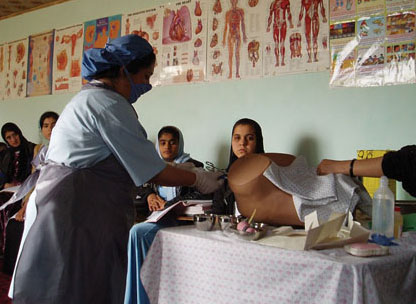By Kelly Brooks-Staub

In Afghanistan, one in six mothers die during childbirth, 86 percent of all babies are delivered without trained health personnel, and 165 infants of every 1,000 die before their first birthday. The country ranks as one of the world’s worst for infant mortality, lifetime risk of maternal mortality, and percentage of births attended by a trained professional.
Midwives historically have played a vital role in the delivery of maternal health services in Afghanistan, where most children are born at home. Yet in 2002, after five years of Taliban rule under which women were not permitted to go to school or work, only 489 midwives remained in the country with a population of nearly 28 million.
In 2004, the Afghan Institute of Health Sciences, part of Afghanistan’s Ministry of Public Health, renewed its commitment to the health of women and infants with the creation of the Community Midwifery Education Program. Funded by the United States Agency for International Development (USAID), the Institute partnered with JHPIEGO, an international health affiliate of the Johns Hopkins University, to develop a professional training program for midwives in Afghanistan.
To enter the training program, students must have a high school diploma. This ranks them among the best-educated women in Afghanistan, which has only a 21 percent literacy rate for women. Yet the educational restrictions imposed on women by the Taliban have impacted these students and the curriculum of the midwifery program.
“After two years of using the curriculum in midwifery schools across Afghanistan, we recognized that the students would benefit from basic science and math and pre-clinical science knowledge that many of them lack due to the restrictions on education during the political unrest,” explains Sheena Currie, JHPIEGO’s Midwifery Advisor based in Kabul, Afghanistan.
In the spring of 2006, JHPIEGO approached the Johns Hopkins University School of Nursing to share its expertise and create learning tools to help train Afghan students in general science and math, anatomy and physiology, and microbiology and pharmacology.
For eight weeks, a team of expert nurse-midwives, obstetric nurses, and community nurses from the school worked to create case studies, audio-visuals, and practical exercises for 41 classes that comprise the program’s first preclinical semester. Under the leadership of Nancy Woods, PhD, CNM, faculty members Mary Terhaar, DNSc, RN; Ellen Ray, MS, CNM; Rosemary Mortimer, MSEd, MS, RN, CCBE; Lisa Kelley, MS, RN; and graduate student Melanie Piedmont, BSN, developed teaching materials that will be translated into Dari and used in more than 20 midwifery schools.
The 805 midwives trained through the program thus far are the first in Afghanistan to undergo a professional two-year training program. The country will eventually need 8,000 to 10,000 midwives to strengthen the overall quality of health care.
“The collaboration between Johns Hopkins University School of Nursing and JHPIEGO was a great example of cross-departmental teamwork,” says assistant professor Nancy Woods. “It is crucial that we take full advantage of the multi-disciplinary expertise available to us in order to create the best possible programs and products that are saving lives beyond our borders. It was a fantastic collaborative experience.”